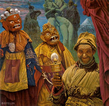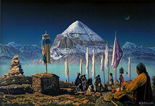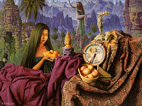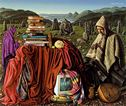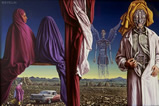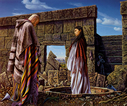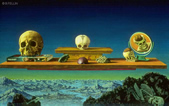Reflections on Mt. Sumeru
Herbert Tichy’s adventurous roaming of the Himalayas prompted my imagination ever since I read his books many years ago. So I gradually dared to communicate those great journeys to the canvas trying to manifest the vastness of this vital sentiment within my paintings.
Thus I was introduced to Tichy this year. I spoke to him about my plan to paint "Kailas", the holy mountain of Tibet, in a realistic way. I immediately got an impressive black-and-white photo of the mountain Tichy had shot fifty years ago.
Tichy was obviously surprised then by a threefold depiction of the mountain seen from different angles with its front emphasized by an enlarged scale. The next step, I explained, would be the depiction of Kailas as centre of the world as envisaged by meditating Hindus, Buddhists and Taoists.
SUMERU meaning the axis of the universe, the concentric point of the mandala in ancient Sanskrit tradition is the mythological name of this mountain. Thus mount Meru not only relates to the physical but also metaphysical world. And since our psychophysical organism is an image of the universe Sumeru corresponds to the spinal column or spinal cord of our nervous system, which is the main channel of subtle energies in our body. The serpent power (kundalini) emerging from Anima passes through various centres of awareness (sanskrit = chakras) on its way up to the seat of enlightened creativity just at the top of the head which is identified with the experience of the superego or nonego, a state the Hindus depict as a thousend petaled lotus (sahasrara-chakra).
Thus the magnetic mountain SUMERU on the roof of the world (the Tibetan plateau) is Shiva’s throne for the Hindus whereas the Buddhists see in this unique summit region the centre of a huge mandala of the Buddhas and Bodhisattvas; a wire of earth to heaven.
SUMERU has been a well-known motif in Asian iconography for thousands of years. There is a lot of contrasting variation of this symbolic idea in the Tibetan tanka painting. I was especially amazed to find this theme in the philosophy of the Thais at least as deeply rooted.
This is only a hint to SUMERU’S significance.
Because I am not a born mountaineer and never got further than looking at the mountains from below, my sources are mainly ideas and consequently my retreat to the easel brings about three dimensional portrayals of the spiritual landscapes within me, at least a little reflecting the great in the small.
The experiences Herbert Tichy made in many countries among all sorts of people for several decades communicate a fascination to me, which may be of a romantic nature. If one has ever listened to his narrations one can understand my honouring his ability to be taken up with people shaped by all sorts of religions and spiritual worlds. The following passage of Herbert Tichy’s first book called "Zum heiligsten Berg der Welt" ("To the holiest mountain of the world"), of 1936, may give a glimpse of this Viennese adventurer’s life.
Benedetto Fellin, Vienna, November 1983 (translated by Ilse Fath-Engelhardt)

Benedetto Fellin - Biografia
1956 in Meran, Südtirol, geboren
1975 Studium an der Akademie der bildenden Künste in Wien,
Meisterschule Prof. Rudolf Hausner
Mostre personali e collettive - Exhibitions - Einzelausstellungen:
1983 Galerie Infeld, Wien
1985 Galerie Infeld, Wien
1987 Visual Dhamma Gallery, Bangkok
1988 Alte Pfarr, Wolfegg, Allgäu
1995 Galerie Pannonia, Sopron
1998 Museum für Völkerkunde, Hofburg Wien
Volksbank Galerie Meran, Südtirol
2001 Freilichtmuseum Gerersdorf, Burgenland
2003 Haus der Kultur, Halbturn, Burgenland
Gruppenausstellungen:
1981 Meisterschüler Prof. Hausner, Tungsram, Wien
1981 Familie Fellin, Kunstpavillon Innsbruck
1982 Rudolf Hausner und Meisterschüler, Kiel
1983 Kinokuniya Gallery, Tokio
1983 Meisterschule Rudolf Hausner, Kirche St. Peter a. d. Sperr, Wr. Neustadt
1987 Benedetto und Markus Fellin, Pavillon de Fleur, Meran
1992 Salon für internationalen Realismus, Fürth
1994 Realismus heute, Stadtmuseum Erlangen
1996 10 Jahre ART Meran, Südtirol
1996 Landschaft heute - Arik Brauer und Schüler, Wiener Wasserwerke
1997 Galerie 1990, Eisenstadt
1998 Österreichische Malerei nach 1945, Österr. Galerie im Oberen Belvedere Wien
2000 Gegenstandliche Kunst in Osterreich, Austria Center, Wien
2001 GEGEN-STAND, Schottenstift Wien
2001 Gegenstandliche Malerei aus Wien, Pasinger Fabrik, Munchen
Preise:
1978 Hausner - Förderungspreis
1983 Akademiefreundepreis
1984 Theodor - Körner - Preis
Öffentliche Ankäufe:
1980 Zentralsparkasse Wien
1981 Landesmuseum Ferdinandeum, Innsbruck
1981 Japanisches Museum, Tokio
1988 Österreichische Galerie, Schloß Belvedere, Wien
1990 Museum Reinhold Messner, Schloß Juval, Südtirol
Bibliographie:
1982 Jens Christian Jensen, „Rudolf Hausner und Meisterschüler“
1983 Dr. Heinrich Fuchs (Hrsg.), Lexikon „Maler des 20. Jahrhunderts in Österreich“,
1985 Peter Infeld (Hrsg.), Monographie „Benedetto Fellin“, Wien
1989 Barbara Wild, „Mitteilungen der Österreichischen Galerie Schloß Belvedere“, Wien
2000 Dr. Roman Schweidlenka, "Religionswissenschaftliches Symposium in Gaz",
Peter Lang Verlag, Frankfurt/M.
2003 Prof. Dr. Walter Schurian, "Verkorperungen", Monographie Benedetto Fellin, Edition Infeld, Wien
